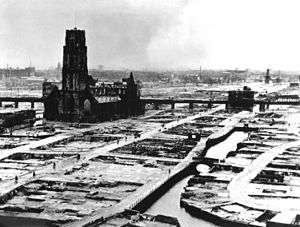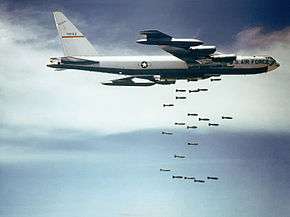Carpet bombing


Carpet bombing, also known as saturation bombing, is a large aerial bombing done in a progressive manner to inflict damage in every part of a selected area of land.[1][2][3][4] The phrase evokes the image of explosions completely covering an area, in the same way that a carpet covers a floor. Carpet bombing is usually achieved by dropping many unguided bombs.
The term obliteration bombing is sometimes used to describe especially intensified bombing with the intention of destroying a city or a large part of the city.[5] The term area bombing refers to indiscriminate bombing of an area,[5] and also encompasses cases of carpet bombing, including obliteration bombing. It was used in that sense especially during World War II.[5] Carpet bombing of cities, towns, villages, or other areas containing a concentration of civilians is considered a war crime[6] as of the 1977 Protocol I of the Geneva Conventions.
Early history

One of the first cases of carpet bombing was by the German Condor Legion during the Spanish Civil War against Republican infantry during the Battle of El Mazuco,[7][8] where the targeted troops were dispersed on rocky slopes and the Condor Legion learned that carpet bombing was not very effective in such terrain.
During World War II
In the European Theatre, the Rotterdam Blitz was an aerial bombardment of Rotterdam by 90 bombers of the German Air Force on 14 May 1940, during the German invasion of the Netherlands. The objective was to support the German assault on the city, break Dutch resistance and force the Dutch to surrender. Despite a ceasefire, the bombing destroyed almost the entire historic city centre, killing nearly nine hundred civilians and leaving 30,000 people homeless. The destructive success of the bombing led the Oberkommando der Luftwaffe (OKL) to threaten to destroy the city of Utrecht if the Dutch Government did not surrender. The Dutch capitulated early the next morning.[9]
As the war progressed, the British built up RAF Bomber Command, which was capable of delivering many thousands of tons of bombs onto a single target, in spite of heavy initial bomber casualties in 1940. The bomber force was then wielded by Arthur Travers Harris in an effort to break German morale and obtain the surrender which Douhet had predicted 15 years earlier. The United States joined the war and the USAAF greatly enforced the campaign. Many cities, both large and small, were virtually destroyed by Allied bombing. W. G. Sebald's book, On the Natural History of Destruction, comments on the carpet bombing of German cities and asks why it does not play a larger part in the German national consciousness, and why virtually no German authors have written about the events. Despite the lack of literary coverage, a style of film shot amongst the urban debris and depicting the gritty lives of those who had to rebuild the destroyed cities called the rubble film, developed in the years after the end of World War II.
Carpet bombing was used as close air support (as "flying artillery") for ground operations. Massive bombing was concentrated in a narrow and shallow area of the front (a few kilometers by a few hundred metres deep), closely coordinated with advance of friendly troops. The first successful use of the technique was on 6 May 1943, at the end of the Tunisia Campaign. Carried out under Sir Arthur Tedder, it was hailed by press as Tedder's bomb-carpet (or Tedder's carpet). The bombing was concentrated in a four by three-mile area preparing the way for the First Army.[10] This tactic was later used in many cases in Normandy Campaign, for example in Battle for Caen.[11]
In the Pacific War, carpet bombing was used extensively against Japanese civilian population centers, such as Tokyo.[12][13] On the night of 9–10 March 1945, 334 B-29 Superfortress heavy bombers were directed to attack the most heavily populated civilian sectors of Tokyo.[14] In just one night, over 100,000 of the population had burned to death from a heavy bombardment of incendiary bombs,[14] comparable to the wartime number of U.S. casualties on the entire Pacific theater.[14] Another 100,000 Japanese were left homeless. These attacks were followed by similar ones against Kobe, Osaka, and Nagoya, as well as other sectors of Tokyo, where over 9,373 tons[14] of incendiary bombs were dropped on civilian and military targets. By the time of the dropping of the atomic bombs on Hiroshima and Nagasaki, light and medium bombers were being directed to bomb targets of convenience, as most urban areas had been already destroyed. In the 9-month long civilian bombing campaign, over 580,000 Japanese civilians died.
Vietnam War
During the Vietnam War, with the escalating situation in Southeast Asia, 28 B-52Fs were fitted with external racks for 24 750-pound (340 kg) bombs under project South Bay in June 1964; an additional 46 aircraft received similar modifications under project Sun Bath.[15] In March 1965, the United States commenced Operation Rolling Thunder. The first combat mission, Operation Arc Light, was flown by B-52Fs on 18 June 1965, when 30 bombers of the 9th and 441st Bombardment Squadrons struck a communist stronghold near the Bến Cát District in South Vietnam. The first wave of bombers arrived too early at a designated rendezvous point, and while maneuvering to maintain station, two B-52s collided, which resulted in the loss of both bombers and eight crewmen. The remaining bombers, minus one more that turned back for mechanical problems, continued toward the target.[16] Twenty-seven Stratofortresses dropped on a one-mile by two-mile target box from between 19,000 and 22,000 feet, a little more than 50% of the bombs falling within the target zone.[17] The force returned to Andersen AFB except for one bomber with electrical problems that recovered to Clark AFB, the mission having lasted 13 hours. Post-strike assessment by teams of South Vietnamese troops with American advisors found evidence that the VC had departed the area before the raid, and it was suspected that infiltration of the south's forces may have tipped off the north because of the ARVN troops involved in the post-strike inspection.[18]

Beginning in late 1965, a number of B-52Ds underwent Big Belly modifications to increase bomb capacity for carpet bombings.[19] While the external payload remained at 24 500-pound (227 kg) or 750-pound (340 kg) bombs, the internal capacity increased from 27 to 84 500-pound bombs or from 27 to 42 750-pound bombs.[20] The modification created enough capacity for a total of 60,000 pounds (27,215 kg) in 108 bombs. Thus modified, B-52Ds could carry 22,000 pounds (9,980 kg) more than B-52Fs.[21] Designed to replace B-52Fs, modified B-52Ds entered combat in April 1966 flying from Andersen Air Force Base, Guam. Each bombing mission lasted 10 to 12 hours with an aerial refueling by KC-135 Stratotankers.[22] In spring 1967, the aircraft began flying from U Tapao Airfield in Thailand giving the aircraft the advantage of not requiring in-flight refueling.[20]
The B-52s were restricted to bombing suspected Communist bases in relatively uninhabited sections, because their potency approached that of a tactical nuclear weapon. A formation of six B-52s, dropping their bombs from 30,000 feet, could "take out"... almost everything within a "box" approximately five-eights mile wide by two miles long. Whenever Arc Light struck ... in the vicinity of Saigon, the city woke from the tremor..
Neil Sheehan, war correspondent, writing before the mass attacks to heavily populated cities including North Vietnam's capital.[23]
The zenith of B-52 attacks in Vietnam was Operation Linebacker II (sometimes referred to as the Christmas Bombing) which consisted of waves of B-52s (mostly D models, but some Gs without jamming equipment and with a smaller bomb load). Over 12 days, B-52s flew 729 sorties[24] and dropped 15,237 tons of bombs on Hanoi, Haiphong, and other targets.[25][26] Originally 42 B-52s were committed to the war; however, numbers were frequently twice this figure.[27]
See also
|
References
- Notes
[3]; -webkit-column-width: [1]
[3]; list-style-type: decimal;">
- 1 2 3 "carpet-bombing". Memidex/WordNet Dictionary. Retrieved 2011-07-25.
- 1 2 3 4 Keane, Michael (2005). Dictionary of modern strategy and tactics. Annapolis (MD): Naval Institute Press. pp. 30–31. ISBN 1-59114-429-9.
- 1 2 3 4 Dickson, Paul (2004). War slang : American fighting words and phrases since the Civil War (2. ed.). Washington, DC: Brassey's. pp. 139, 209, 303–304. ISBN 1-57488-710-6.
- ↑ Gooderson, Ian (1997). Air power at the battlefront : allied close air support in Europe, 1943–45 (1. publ. ed.). London: F. Cass. p. 129. ISBN 0-7146-4680-6.
- 1 2 3 4 5 6 Primoratz, edited by Igor (2010). Terror from the sky : the bombing of German cities in World War II (1. publ. ed.). New York: Berghahn Books. pp. 45–53. ISBN 1-84545-687-4.
- ↑ http://www.crimesofwar.org/a-z-guide/carpet-or-area-bombing/
- ↑ Juan Antonio de Blas, "El Mazuco (La defensa imposible)" (pp369–383), in La guerra civil en Asturias, Ediciones Júcar, Gijón 1986.
- ↑ excerpt from de Blas source translated to English "El Mazuco (the impossible defence)"
- ↑ Hooton 2007, p. 52.
- ↑ Richards, Denis (1975). "XII Torch and Tunisia". Volume II: The Fight Avails. The Royal Air Force: 1939–1945 (Pbk. ed.). London: H.M.S.O. pp. 270–271. ISBN 0-11-771593-X
- ↑ Levine, Alan J. (1992). The strategic bombing of Germany : 1940–1945 (1. publ. ed.). Westport, Conn. u.a.: Praeger. pp. 141–142. ISBN 0-275-94319-4.
- ↑ "Tokyo remembers 1945 bombing raid". BBC News. 10 March 2005. Retrieved 1 April 2010.
- ↑ http://www.ieer.org/comments/bombing.html,
- 1 2 3 4 Nie, Jing-Bao (17 August 2010). Japan's Wartime Medical Atrocities: Comparative Inquiries in Science, History, and Ethics. ISBN 9780415583770.
- ↑ Lake International Air Power Review Summer 2003, p. 103.
- ↑ Anderson, William. "Guam Jets Bomb S. Viet." Chicago Tribune, 18 June 1965.
- ↑ Hobson 2001, pp. 22–23.
- ↑ Schlight 1988, p. 52.
- ↑ Lake 2004, p. 30.
- 1 2 Dick and Patterson 2006, p. 161.
- ↑ Knaack 1988, p. 256.
- ↑ Donald 1997, pp. 161–162.
- ↑ Condor 1994, p. 37.
- ↑ Dick and Patterson 2006, p. 187.
- ↑ Condor, 1994, p. 38.
- ↑ Budiansky 2004, p. 394.
- ↑ Lake 2004, p. 32.
External links
- "Bombs Over Cambodia" from The Walrus